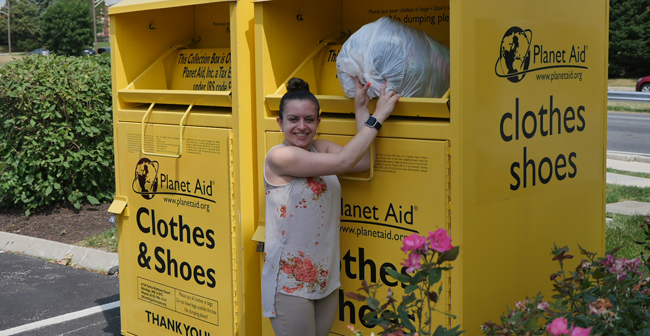Culture
 Photo: Courtesy of John Nagiecki
Photo: Courtesy of John Nagiecki
Saving the Planet, One T-Shirt at a Time
March 31, 2018 @ 12:00am
Imagine you’re a T-shirt – a comfy, cotton blend, perfect for lazing around the house or showing off your favorite sports team. One day, your owner will buy a new T-shirt to replace you, well before you are ready to say goodbye. And more often than not, you will end up rotting to death in a landfill with more than 25 billion pounds of other unwanted textiles that are tossed out in the U.S. each year, according to the Council for Textile Recycling (CTR). It’s really very sad.
Of the 82 pounds of textile waste each U.S. resident produces annually on average, CTR reports that only 15 percent find a new home through donations or recycling. The remaining 85 percent go to landfills, where textiles make up 5 percent of all municipal solid waste generated in the U.S. each year. And it’s only getting worse.
Between 1999 and 2009, the amount of post-consumer textile waste increased by 40 percent, while the amount of waste diversion only grew by 2 percent. CTR estimates that by 2019, the U.S. will generate 35.4 billion pounds of textile waste in a single year. Sometimes it’s easier to just read past these numbers without taking the time to think about how much a billion really is, so let’s see if this helps.
One billion seconds is 30 years. One billion golf balls laid side-by-side would circle the earth. One billion raindrops would fill approximately 50 bath tubs. And one billion paperclips would weigh as much as 200 elephants.
Now multiply that by 35. That’s how many pounds of textile waste the U.S. is projected to produce in 2019. And this isn’t even including the rest of the world.
The Ellen MacArthur Foundation published a report stating that if production continues at this rate, the fashion industry will use up a quarter of the world’s carbon budget by 2050. Half a million tons of microfibers are released into the ocean every year, which is equivalent to more than 50 billion plastic bottles. These microfibers are nearly impossible to clean up and can enter food chains, destroying habitats and species of marine life.
After realizing all of the harm caused by textile waste, we’re left with one question: what can we do to make a difference?
The District’s Department of Energy and Environment (DOEE) is trying to find the answer. On March 14, Sustainable DC – the DOEE’s plan to become the healthiest, greenest and most livable city in the nation by 2032 – launched ReThread DC, an initiative to create a culture of recovery and reuse in the nation’s capital through outreach and education. Danielle Nkojo, a sustainability analyst for waste and materials management on the DOEE’s urban sustainability team, founded ReThread because of her personal passion for thrifting and extending the life of her clothing, as well as her experience as a waste policy expert.
“I look at the fact that about 90 percent of the textiles that are out in the waste stream are usually reusable,” Nkojo says. “I thought it would be great to bring my unique interest in that to the core development of eventual policy to divert textiles from the waste stream.”
Sustainable DC has helped waste management policy before. Have you ever noticed that DC restaurants don’t hand out Styrofoam take-out boxes anymore? That’s because in 2014, the DC Council banned all food-serving businesses and organizations in DC from using containers or other food service products made from Styrofoam beginning January 1, 2016. The ban also requires these businesses and organizations to use recyclable or compostable products, which is helping Sustainable DC’s goal of diverting 80 percent of waste in the next decade.
Because they launched only a few weeks ago, ReThread is a long way from working toward major policy changes. However, Nkojo says that will come in the future. Right now, ReThread’s main focus is to answer the question, “What can I do with my unwanted clothing and textiles?” But before we answer that, we need to turn our attention to what you can do to reduce your personal textile waste output in the first place:
***
Now, imagine you’re a T-shirt again. Maybe you’re a different one this time. You’re about to be thrown out and cast aside, but instead, you end up in the arms of a new owner – one who treats you like a diamond in the rough or buried treasure, who discovered your worth after hours of digging through bins full of other tees that are also waiting to find their next home. Feels good, right?
When you feel like cleaning out your closet this spring, you can do your ex-favorite T-shirt one last favor by donating it to a local organization that will help find its next owner. And that next owner could really be in need of a new shirt. That’s where Clothing Recycling Company (CRCO) comes in.
Since 1999, CRCO has served the DMV with its attention to detail, local touch and family-owned approach to redistributed second-hand textiles. The organization partners with Interfaith Works in Maryland, Christ House in DC and A-SPAN in Arlington to help low-income families and the homeless gain access to nice, affordable clothing and wares.
CRCO Assistant Director Vlad Brostky says that one of the special things about the organization is its connection to the community. Because CRCO only collects and distributes in the greater DC area, the operation is small – but the impact is great.
When asked about why keeping it local is so important to the organization, Brostky says that CRCO wants donators to know exactly where their clothing and wares are going – whether it’s to homeless people through A-SPAN or families in need through Interfaith Works.
“This is why we’re staying small and local, but there are bigger companies that recycle huge amounts of clothing, and they are focusing on just getting as much as possible,” he says. “Basically, it’s just a mass market of clothing recycling.”
He’s referring to the secondhand clothing trade – a goliath operation where certain secondhand clothing collectors export their surplus donations to developing countries in Africa. Since 2016, the governments of the East African Community laid out a plan to prohibit all secondhand clothing imports by 2019 to boost domestic manufacturing.
In March, the Office of the United States Trade Representative responded with a threat to impose trade sanctions on African nations and announced an out-of-cycle review of the eligibility of Rwanda, Tanzania and Uganda to receive benefits under the African Growth and Opportunity Act, which enhances U.S. market access for qualifying Sub-Saharan African countries.
The reality is that although the exporters themselves benefit the most from this secondhand clothing trade, there are still many people and communities that receive help from foreign organizations dedicated to empowerment and positive change in developing nations.
***
One such organization is Planet Aid, a nonprofit based in DC that collects and recycles used textiles to protect the environment and support sustainable development around the world. Planet Aid uses its proceeds from selling used clothing overseas to implement programs that support teacher training, help subsistence farmers find a path out of poverty, educate people on HIV/AIDS prevention and more.
Planet Aid Communications Director John Nagiecki says that while there is little demand for secondhand clothing in the U.S., the secondhand economy in the developing world is very robust and provides a good source of employment and an affordable source of clothing. He also says that Planet Aid sells its clothing instead of giving it away because “such an attempt would undermine the secondhand economy on which so many people rely for their livelihood and countries thus refuse to accept such handouts.” Although there are conflicting opinions about the secondhand clothing trade in developing countries, both sides can agree that something greater must be done to fix our massive textile waste problem.
“The real issue that must be addressed is the rise of fast fashion in the U.S. and other developed nations,” Nagiecki says. “We simply consume too much clothing.”
Brostky concurs.
“[CRCO] recycles thousands of pounds of clothing a month, which is nothing compared to what America really consumes, but we still are helpful,” he says. “People should be more educated about it.”
Ultimately, Nkojo, Brostky and Nagiecki all agree that one of the best ways to fight textile waste is to educate and inform the public so that they can make their own decisions on buying less and recycling more.
“The function of how we get people to care is just letting them know how much is being wasted, and how they could change simple habits that could really have a huge impact,” Nagiecki says. “To the extent that they can, we encourage people to adopt these practices so that their clothing consumption can go much further.”
Picture this. You’re a T-shirt on its way to the clothing recycling bin at the end of the block. You’re sad to say goodbye to your beloved owner, but there’s some reassurance in the new opportunities waiting for you on the other side. You could become a ball of yarn, then woven into a new scarf or blanket. You could become a quilt or a handbag or fancy needlework on someone’s hand-designed jeans. Your future is bright, and you’re happy knowing that you did your part in keeping the earth clean. Let’s keep it that way.
Learn more about these DC-based organizations and initiatives at their websites.
Clothing Recycling Company: www.clothingrecyclingcompany.org
Planet Aid: www.planetaid.com
Sustainable DC: www.sustainabledc.org







